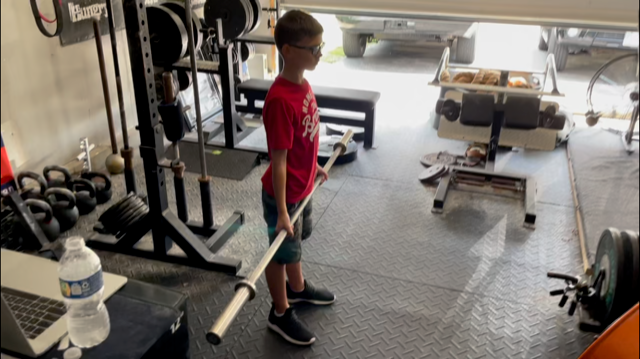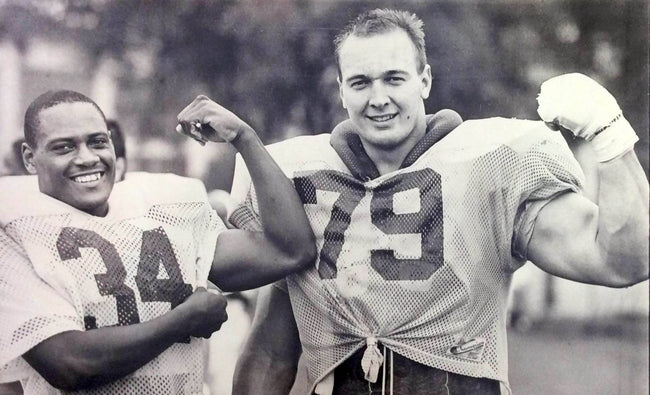Note: This article was written years ago for the Jim Wendler Forum. However, it is still very relevant and would be a welcome addition to anyone's training arsenal. - Jim Wendler
Wednesday is Bench Press Day in London, Ohio. The bench press is one of our three main lifts but it's used mostly as a “muscle and strength” movement rather than a power/strength movement (squat/deadlift). What this means is that the first goal of lifting for most of the kids is to build muscle mass – you can’t flex fat and bone. And invariably the squat and deadlift, at this level, are best done for lower reps so that form doesn’t go to shit. This doesn’t mean you go super heavy – it means you use appropriate weight that allows the reps to performed with correct technique and power. People disagree with me on this and I’m OK with that – but considering the group of kids I’m training and the amount of kids I’m training at once, I have to be smart. The lower body volume is done with assistance movements. Even if that concept isn't popular, I find from experience, it works best for this population.
However, with the bench press – I’m not terribly concerned with a lot of this. So we had some fun with the bench press this week. I trained two different groups of three athletes each group. We are on our 3x5 week. The New Rule of 10 reps was such that each kid “owed” me 10 reps at each of the five bench press sets that were done; the two warm-up sets (very easy) and the three work sets (65/75/85).
After each set of bench press, each kid “owed” me (or really themselves) 10 reps of DB squat and 10 reps of DB SLDL. The one caveat was this – if you could not get 10 reps on a set (say you got 7 reps) – you racked the bench press bar – did another 10 reps of DB squat/DB SLDL and then got back on the bench press to finish the 3 reps that are owed. We had one kid who did a total of 8 sets of bench press and another that had to do 10 sets. This is a lot of squats and DB SLDL reps. The kids that I chose to work with loved the challenge and didn’t see it as punishment. So for example – here was what one of the kids did, set for set (not counting the empty barbell and other calisthenics prior to training.)
Bench Press – 95 x 10
DB Squat – 100 x 10
DB SLDL – 80 x 10 (2, 80lbs DB’s)
Bench Press –135 x 10
DB Squat – 100 x 10
DB SLDL – 80 x 10
Bench Press – 155 x 10
DB Squat – 100 x 10
DB SLDL – 80 x 10
Bench Press – 175 x 9
DB Squat – 100 x 10
DB SLDL – 80 x 10
Bench Press – 175 x 1
DB Squat – 100 x 10
DB SLDL – 80 x 10
Bench Press – 195 x 5
DB Squat – 100 x 10
DB SLDL – 80 x 10
Bench Press – 195 x 3
DB Squat – 100 x 10
DB SLDL – 80 x 10
Bench Press – 195 x 2
DB Squat – 100 x 10
DB SLDL – 80 x 10
We didn’t use a clock/timer or time the rest periods – it was just supposed to be a fun/stupid day of training. We finished the day (for these guys) with a bunch of chin-ups/pull-ups. As a side note: the entire session, from warm-up to chin-ups took about 50 minutes. So the kids weren’t standing around, bullshitting. The guys in these groups, who finished earlier, had to spot and do their chin-ups/pull-ups.
This is not something I’d do every day and probably only works on 3x5 week (depending on your Training Max, of course). I’d also not do it on deadlift day; maybe on squat day for those who are strong enough to hold positions while fatigued.
Learning how to hold an arch is one reason why assistance work is so important and why rowing is such an important movement. Especially DB rows and chest supported rows. People love to praise the bent over row as being God’s Gift to the World; the problem is that in order to do that movement correctly, you have to be strong enough to do the movement. It’s kind of like trying to get a first job; they want you to have experience but you can’t get experience until you get a job.
The big emphasis that I spoke about this week was keeping a training log on every lift that is done. Since we do a lot of assistance work, it’s important that they keep track of the weights/reps of every set they do. I have referred to this aspect of training as “personal sovereignty”. They are responsible for getting stronger on these lifts and always challenging themselves; these include all DB movements (pressing/rows), overhead press, DB squats, curls and chin-ups/pull-ups. If they are currently performing 10 reps with the 35lbs DB’s on incline press – and continue to do this all year long – they aren’t getting any stronger. However, if they track their training, actually read their training logs and choose to push themselves, like magic – they will get stronger. And have proof that they are indeed stronger. I don’t understand why someone wouldn’t keep a training log if they were serious. Although some claim they are useless, those people are invariably beginners who seem to have all the answers to none of the questions. It's way easier not to notice your failing when you never track growth. If you shy away from the idea of writing a training log, you might have to consider that you just don't want to face that your training is sporatic and lacking any real commitment or personal development.
While I do take the position of a coach seriously and I do understand that these kids’ physical improvement is my responsibility – there needs to be some personal responsibility displayed. And writing your own lifts down in a plain notebook you picked up in the grocery store isn’t asking for much.






